Last Updated on August 28, 2023 by Michelle
I was sharing on instagram stories yesterday how much I love dehydrating tomatoes, and that led to lots of folks sending me lots of questions… so I guess it’s time I start writing some about what food I dehydrate, why, and how I use all this deliciousness.
To start, today I’m sharing how I use my dehydrated tomatoes… Join me over on instagram for lots more real food deliciousness, from dehydrating to fermenting; from free ranging chickens to pasture-raised pork… I share about it all, daily, and hope you can join me there.
And be sure to catch the new, upcoming season on my Simple Doesn’t Mean Easy podcast, all about Real Food.
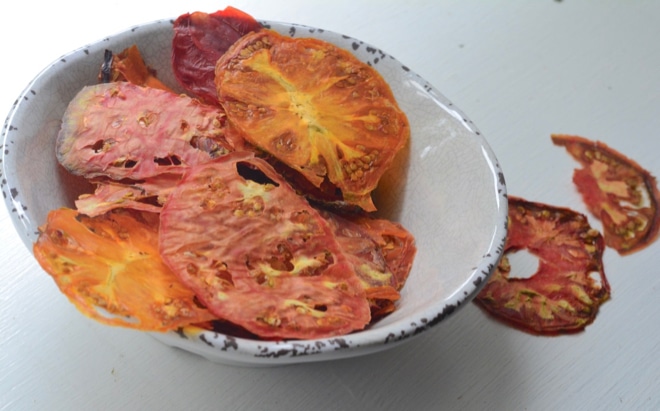
Benefits of Dehydrated Food
Dehydrating food can save you money, help you preserve food instead of wasting it, and even speed up your cooking time. You can also add seasonings to food as you dry it, or leave them completely natural. Either way, with dehydrated fruits and veggies, you have lots of healthy, easily portable snacks on hand.
But maybe the best part of dehydrating food? The dehydrating process completely retains a food’s original nutritional value! Most food preservation decreases a food’s nutritional content, but dehydrating retains all the protein, fat, carbohydrates, fiber, and vitamins. Amazing, right?
So if you have a surplus of any fruit or veggies in your kitchen right now, roll up your sleeves and start slicing them and filling up your dehydrator trays today, guys.
For me today, it’s tomatoes that have taken over my counters and kitchen table. Which I happen to be very happy about.
In future posts I’ll outline the details of the dehydrating process for tomatoes, as well as which varieties of tomatoes are best to grow if you want to dehydrate them to preserve them, but for now let me inspire you with the many ways I will be using a stockpile of amazing dehydrated tomatoes…
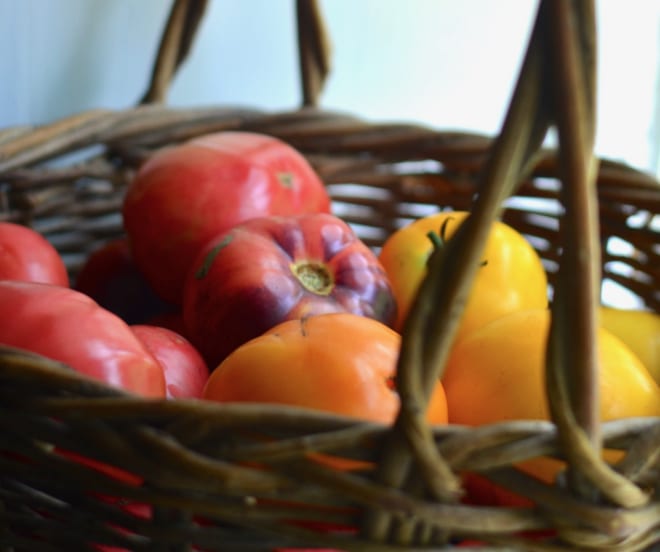
How to Use Dehydrated Tomatoes
Drying tomatoes is, in my opinion, the best, easiest, and most nutritious way to preserve an abundance of summer tomatoes.
Dehydrated tomatoes have a wonderful, concentrated, sweet tomato flavor, that is a fantastic addition to so many things in the kitchen…
- Serve them with cheese, meats, and crackers for an amazing charcuterie board
- Chop up and add as a boost of amazing flavor (and nutrition) to almost anything (think soup, dips, sandwiches, pasta salad)
- Use as a pizza topping
- Toss in some cut up dehydrated tomatoes in your sautéed veggies
- Enjoy them in any savory breads or baked goods
- Add small pieces to fresh green salads
- Reconstitute and marinate them for amazing tomatoes to add to any recipe (see directions below)
- Make tomato powder that you can shake on any dish at all for seasoning and nutrition
- Reconstitute tomato powder for pizza sauce (Go here for the full directions on making pizza sauce with powder.)
- Enjoy them as a flavorful little snack, just as they are
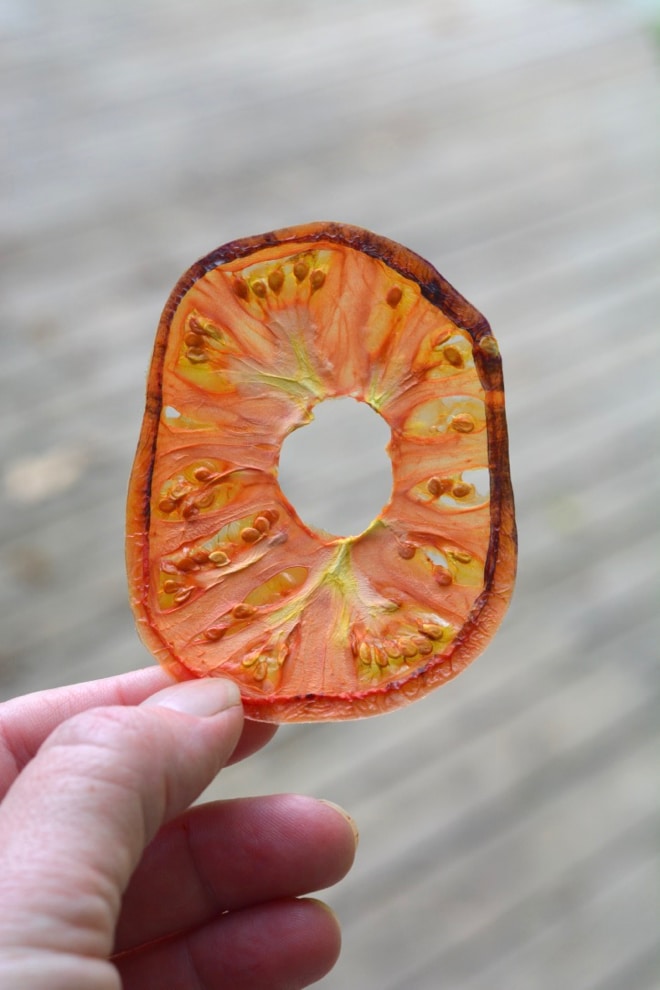
How to Reconstitute Dehydrated Tomatoes
If you’d like to reconstitute your dehydrated tomatoes, it’s super easy. Simply soak the dehydrated tomatoes in a bowl of warm water for an hour or two. They will be very similar in size, feel, and taste to a fresh tomato and you can use them in the same way.
You can also soak dehydrated tomatoes in high-quality olive oil to serve as an extra special side dish.
TIP: For added “umph,” soak dehydrated tomatoes in wine or broth instead of just water to rehydrate them.

How do you reconstitute dehydrated tomatoes?
You won’t believe how easy it is to reconstitute dehydrated tomatoes. Simply soak them in a small bowl with just enough warm water to cover them. Let them sit for at least 10 minutes, but an hour is best. They’ll be a mushier consistency than fresh-picked, firm tomatoes, but they’re great to use in so many ways and they taste amazing.
Can you cook with dehydrated tomatoes?
If you want to add your dehydrated tomatoes to a liquid-y recipe, like a soup or a roast, no need to reconstitute your tomatoes first, otherwise just soak them in water, as explained above
How to Rehydrate & Marinate Dehydrated Tomatoes
If you would like to add your dehydrated tomatoes to a salad, or any non-heated dish really, soak them in warm water with a little vinegar for about an hour to rehydrate them. After draining them, mix them with olive oil, fresh minced garlic, and fresh basil leaves, and marinate overnight. Wow. You’ll love the results and find yourself thinking of all kinds of ways to use this deliciousness.
Do dehydrated tomatoes need to be refrigerated?
Dehydrated tomatoes are shelf stable for years, no need to refrigerate or do anything special. I keep mine in a glass jar, with a stainless steel lid that has a great seal, in my root cellar. But any dark, cool location will work (if it is consistently the same temperature year-round, that is ideal).
What is the Best Dehydrator?
I have tried many different dehydrators over the years, trying to save money with lower priced ones. I’ve also dehydrated many herbs by hanging them to air dry and many veggies by spreading them out on baking trays on the dashboard of my car on a hot sunny day.
While there are many ways to dehydrate without fancy equipment, and many lower priced dehydrating machines on the market that are fine, I can tell you I will never go back to any other way now that I have found the top echelon of dehydrators.
This is my dehydrator and I whole heartedly recommend it to anyone who asks.
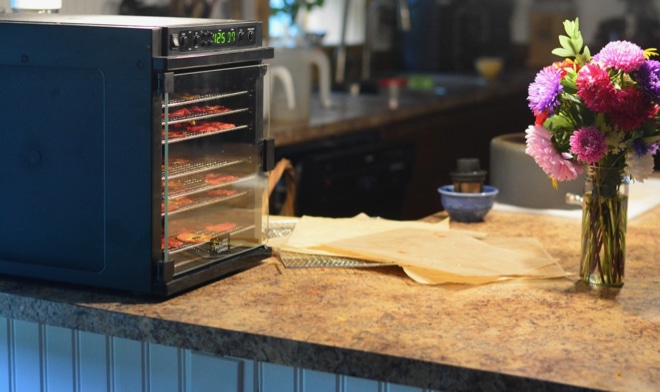
It is an investment, but the way it churns out high-quality food for my family on a regular basis, and the high-quality parts and stainless steel trays, make it very worth the investment for me. Plus, it’s paid for itself many times over.
Listen in to More About my Dehydrator
Other Articles You’ll Enjoy:
How to Make Sauce With Tomato Powder
The Best Tomatoes to Dehydrate
8 Gardening Tips, Inspired by the Pros
The Tools I Use the Most in my Farmhouse Kitchen
Talk to me!
If you have any questions, leave a comment below. And please tag me on ig to show me your delicious dehydrated food @souly.rested.
Pin this for later!
Click on the image below to pin this post.
“Listen, listen to me, and eat what is good, and you will delight in the richest of fare.” Isaiah 55:2
Find out why SoulyRested was considered to be one of the Top 20 Must-Read Homesteading Blogs of 2018 and then one of the Top Homesteading Blogs of 2019 as well.
I’d love to connect!
To find me in some other neck of the woods, just click any (or every!) icon below:


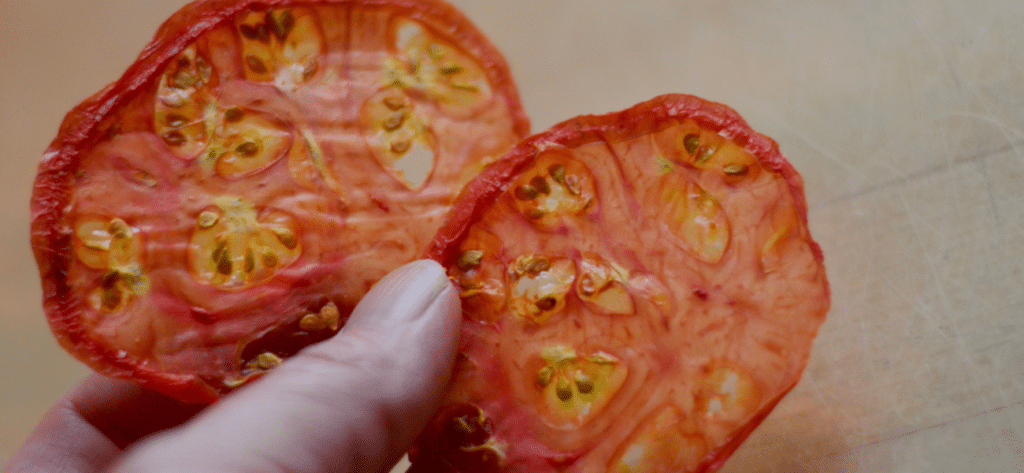
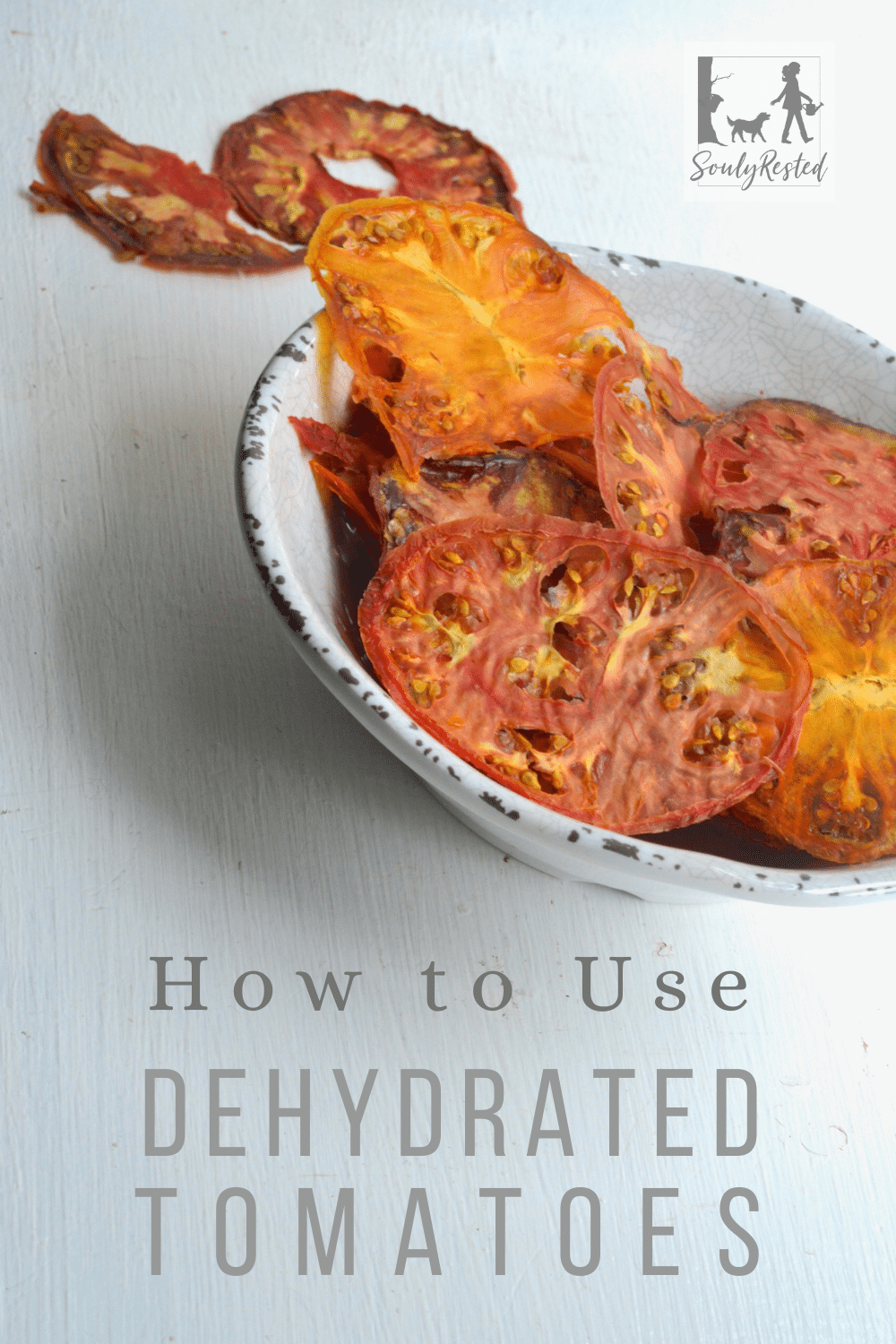





I did dehydrate some tomatoes and they were great! Even good for a snack. But as they sat, sealed in the jars, they turned dark. They looked terrible and we didn’t want to eat them. What did I do wrong? Please, I’m being happily overrun with tomatoes! Thank you
I’ve never had this happen… hmmmmm, do you have a great dehydrator? Did you condition them? (keep them in lidded container and shake vigorously many times a day for a week, removing and re-dehydrating any that stick together or to the sides of the container)
Thank you! I need to start all over with this. I didn’t know about the conditioning. So that is the answer. I put them in freezer bags and checked them but must have missed the moisture. Thank you for taking the time to explain to me. Kathy
Forgot to say. I have two Excaliber dehydrators. Too much invested in them to start with a new one.
If I have Dehydrated my tomatoes for 14 hours they look so all I do now is put them in a jar , can I put an oxygen absorbers in them and just keep an eye on them I sliced them and put them on parchment paper
There are so many variables, I can’t tell you if they’re “done” but you can tell by the feel of them. They should be crisp, like paper, but still (mostly) pliable. I don’t use oxygen absorbers, but they can’t hurt I guess. Be sure to condition them–which means shaking them many times a day and making sure they don’t stick to each other or the jar–before storing away.